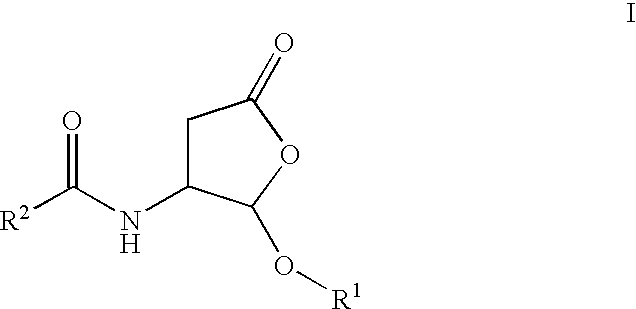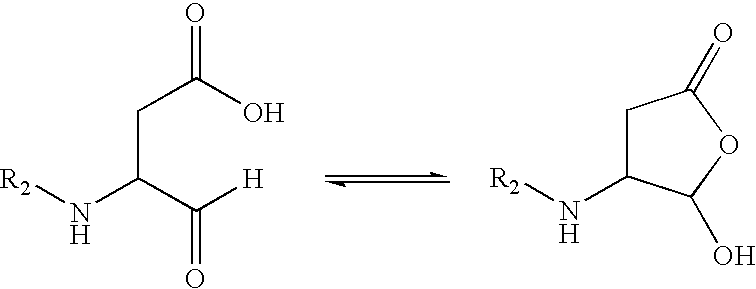Process and intermediates for making substituted aspartic acid acetals
a technology of aspartic acid acetals and intermediates, which is applied in the field of cysteine protease enzymes, can solve the problems of chromatographic separation of diastereomers, significant disadvantages of route, and high cost of starting materials in the process
- Summary
- Abstract
- Description
- Claims
- Application Information
AI Technical Summary
Problems solved by technology
Method used
Image
Examples
example 1
Preparation of 4-azido-5-ethoxy-dihydrofuran-2-one (III, R.sup.1=Et)
[0076] This procedure was carried out in a manner similar to that described by D. J. Guerin, et al., Org. Lett (1999), 1, 1107-1109. To a solution of azidotrimethylsilane (25.8 mL, 0.32 mol) in dichloromethane (400 mL) at room temperature under nitrogen was added acetic acid (18.1 mL, 0.32 mol), and the reaction was stirred for 20 min. 5-Ethoxy-5H-furan-2-one (II, R.sup.1=Et) (8.10 g, 0.063 mol) was added dropwise, followed by 1,8-diazabicyclo[5.4.0]undec-7-ene (1.9 mL, 0.013 mol). The reaction was stirred for 24 h, washed with sodium bicarbonate, dried over sodium sulfate and evaporated. Purification by flash chromatography (SiO.sub.2) eluted with 1:9 ethyl acetate:hexanes afforded 4-azido-5-ethoxy-dihydrofuran-2-one (7.85 g, 73% yield) as a colorless oil.
[0077] .sup.1H-NMR (500 MHz, CDCl.sub.3) .delta. 5.17 (s, 1H), 4.00 (dd, J=7.0, 1.0 Hz, 1H), 3.71 (m, 1H), 3.49 (m, 1H), 2.77 (dd, J=17.0, 6.0 Hz, 1H), 2.32 (dd, ...
example 2
Preparation of 4-[(triphenylphosphoranylidene)-amino]-5-ethoxy-dihydrofura-n -2-one (V, R.sup.1=Et)
[0079] A solution of 4-azido-5-ethoxy-dihydrofuran-2-one (0.05 g, 0.29 mmol) and triphenylphosphine (0.078 g, 0.29 mmol) in toluene (5 mL) was stirred at room temperature under nitrogen for 5 h. The solvent was evaporated to afford 4-[(triphenylphosphoranylidene)amino]-5-ethoxy-dihyd-rofuran -2-one (0.12 g, 100% yield) as an off-white, waxy solid. .sup.1H-NMR (500 MHz, CDCl.sub.3) .delta. 7.50 (m, 6H), 7.40 (m, 3H), 7.33 (m, 6H), 5.08 (d, J=3.1 Hz, 1H), 3.63 (m, 1H), 3.23 (m, 1H), 2.50 (dd, J=17.1, 5.9 Hz, 1H), 2.27 (dd, J=17.1, 5.9 Hz, 1H), 0.91 (t, J=7.0 Hz, 3H) ppm.
example 3
Preparation of (R)-2-(2-ethoxy-5-oxo-tetrahydrofuran -3-ylcarbamoyl)-pyrrolidine-1-carboxylic Acid Tert-Butyl Ester (I, R.sup.1=Et)
[0080] Method 1. From 4-azido-5-ethoxy-dihydrofuran-2-one Via Hydrogenation:
[0081] A mixture of 4-azido-5-ethoxy-dihydrofuran-2-one (1.06 g, 6.2 mmol), (S)-pyrrolidine-1,2-dicarboxylic acid 1-tert-butyl ester (1.33 g, 6.2 mmol), and 10% palladium on carbon (0.50 g) in ethyl acetate previously degassed with N.sub.2 (50 mL) was stirred under 1 atm hydrogen at room temperature for 1 h. The mixture was diluted with dichloromethane, filtered (Celite) and evaporated. The crude mixture was dissolved in dichloromethane (100 mL), was treated with diisopropylethylamine (5.4 mL, 30.8 mmol), EDC (1.48 g, 7.71 mmol), and HOBT (1.04 g, 7.71 mmol) and was stirred at room temperature under nitrogen for 24 h. The reaction was diluted with ethyl acetate, was washed with 10% sodium bisulfate, saturated sodium bicarbonate, and brine, was dried over sodium sulfate, and was e...
PUM
| Property | Measurement | Unit |
|---|---|---|
| Time | aaaaa | aaaaa |
| Time | aaaaa | aaaaa |
| Digital information | aaaaa | aaaaa |
Abstract
Description
Claims
Application Information
 Login to View More
Login to View More - R&D
- Intellectual Property
- Life Sciences
- Materials
- Tech Scout
- Unparalleled Data Quality
- Higher Quality Content
- 60% Fewer Hallucinations
Browse by: Latest US Patents, China's latest patents, Technical Efficacy Thesaurus, Application Domain, Technology Topic, Popular Technical Reports.
© 2025 PatSnap. All rights reserved.Legal|Privacy policy|Modern Slavery Act Transparency Statement|Sitemap|About US| Contact US: help@patsnap.com



